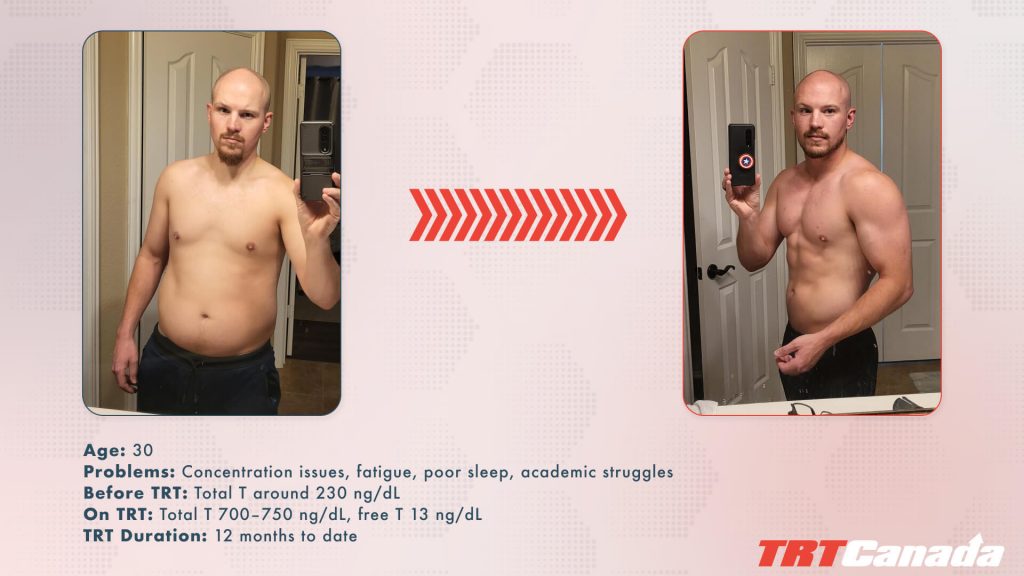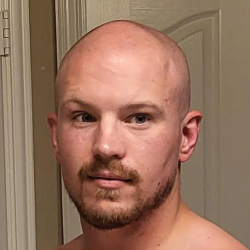
Sam Peterson had found himself grappling with a range of symptoms most people wouldn’t associate with someone who’s only 30 years old. He always struggled to concentrate on monotonous tasks at his work (logistics at a shipping yard), felt sluggish and unmotivated. He couldn’t enjoy life like many of his friends did. Instead, he found himself falling behind, blaming himself for the lack of discipline and fatigue.
On top of it all, Sam couldn’t get much sleep: he had trouble falling asleep, and even if he did, its quality was mediocre at best.
“I used to think I was just lazy. I’d go to work, zone out halfway through the shift, and then blame myself for not staying focused. It got so bad that even eight hours of sleep felt like three or four. I knew I had to figure out the real cause.”
Sam’s Life Before TRT: Zoning Out
Sam’s lack of progress at work and his ongoing struggles — particularly with concentration and stamina — led him to suspect that there was more to his difficulties than just mental or emotional blocks.
Between the daytime exhaustion and nighttime insomnia, Sam’s overall well-being deteriorated. Initially, he tried self-help solutions — taking multivitamins, forcing himself to wake up earlier for a jog, even attempting various “miracle” supplements. But none of these brought any relief.
Appointment at TRT Canada and the Testosterone Deficiency
After the consultation, TRT Canada’s specialists have acknowledged that while stress or poor sleep habits can sometimes explain fatigue, Sam’s case sounded more complex. They requested a blood panel, including hormone levels and metabolic markers.
When the results came in, one thing in particular stood out. Sam’s total testosterone measured drastically below the normal reference range for a man in his 30’s:
- Total Testosterone: Hovering around 230 ng/dL — where the typical range for a healthy 30-year-old often starts closer to 400 ng/dL and can extend well into the 800–900 ng/dL territory;
- Additional Markers: His estradiol was on the middle side of the reference, but the doctor noted it could shift once testosterone levels started to rise. RBC, hematocrit, and other metabolic indicators were within normal limits, ruling out immediate secondary complications.
TRT Canada’s experts have explained to Sam that low testosterone can cause a decrease in energy levels and concentration, and the quality of the sleep.
Designed Treatment Plan and TRT Canada Recommendations
At first, Sam felt nervous about starting testosterone replacement therapy. He worried about potential side effects and how invasive the injections might be, but we outlined a gradual escalation in dosage, monitoring Sam’s hormone levels every few weeks to ensure his body responded appropriately.
Sam’s therapy extended beyond just testosterone injections. To optimize his treatment, he was also encouraged to:
- Light strength training two to three times a week, with an emphasis on proper form to prevent injuries;
- Consistent bedtime, minimizing screen time before bed, and possibly adding brief meditation or reading to wind down;
- Incorporating more lean proteins, complex carbs, and essential fats, thereby supporting hormone regulation and muscle recovery.
Though Sam had never been fond of exercising, knowing this was part of a larger medical plan gave him the determination to try. Step by step, he integrated manageable 20-minute workouts, improving his stamina and gradually building confidence.
First Improvements: Sixth Week Mark vs Three Months Mark
About six weeks into his program, Sam returned for a fresh set of labs. His total testosterone had risen to roughly 500 ng/dL, indicating that the therapy was starting to take hold. Free testosterone also showed moderate improvement, though it still lagged behind ideal levels.
We opted to continue with the same dose and schedule, reminding Sam that big changes often reveal themselves around the three-month mark.
Sam’s day-to-day improvement wasn’t immediate, but by the two-month mark, he began noticing subtle shifts:
- Staying awake through lectures felt more manageable, and he no longer needed two energy drinks just to get through his shift;
- Nightly tossing and turning grew less frequent. He found himself falling asleep more quickly and waking up with fewer interruptions.
What surprised Sam most was how these changes impacted his mood. While he wouldn’t describe himself as having been depressed, he had lived under a cloud of demotivation for years.
By the time he hit the three-month lab check, Sam’s total testosterone hovered around 600 ng/dL, a marked improvement from his baseline. His free testosterone climbed further as well, thanks to a slight dip in SHBG. Crucially, his estradiol remained in a healthy zone — no signs of spiking that might require additional interventions.
First Year on the Testosterone Replacement Therapy: Sam’s Report
Now, with nearly twelve months of TRT and complementary lifestyle changes, he stands among the top performers at work.
His managers, as we were told by Sam, took note of the stark difference, and his dedication made him a way more sought-after specialist.
“I went from feeling like I was constantly drowning to finally catching a wave and riding it. That sense of achievement is something I never thought I’d experience. I was blaming myself for so long — when in reality, there was a genuine deficiency holding me back. TRT gave me the fuel to follow through on all the hard work I wanted to do but just couldn’t.”
Recent bloodwork shows his total testosterone consistently in the 700–750 ng/dL range, while free T remains robust and balanced. His estradiol is well within normal boundaries, and he hasn’t experienced any alarming upticks in hematocrit or red blood cell counts.
YOUR OWN JOURNEY TO HORMONAL BALANCE, OPTIMIZED PERFORMANCE AND PEAK PHYSIQUE CAN START NOW: WITH TRT CANADA







